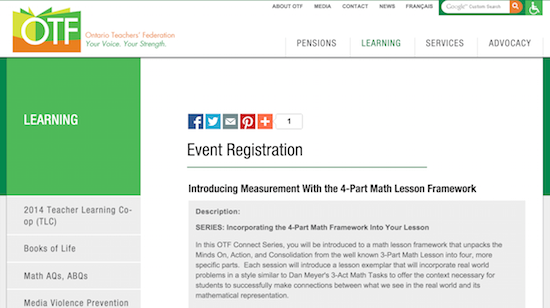Curriculum Tags: All
http://robertkaplinsky.com/why-depth-of-knowledge-is-critical-to-implement/
Kyle at the Tap Into Teen Minds blog is putting on a Webinar on the 4-part math lesson on March 9th at 7:30PM. Check out the info here. Hopefully you will see this before then.
Curriculum Tags: All
https://tapintoteenminds.com/2015/03/02/join-march-9th-free-otf-connect-webinar/
Curriculum Tags: MPM1D, MFM2P
http://reasonandwonder.com/match-my-line-%E2%80%A2-create-your-own/
Curriculum Tags: Gr7, Gr8, MPM1D, MFM2P
http://reasonandwonder.com/visual-patterns-desmos-amazing/
Curriculum Tags: MPM1D, MFM1P, MDM4U, MAP4C
http://mrorr-isageek.com/?p=3736
 I know it's not Pi Day yet. But this year's Pi Day is a one-in-a-century event 3-14-15 at 9:26:53 won't happen again until another 100 years has passed. So here's a link to my Pi Day Pinterest board (which I will probably post again next week)
I know it's not Pi Day yet. But this year's Pi Day is a one-in-a-century event 3-14-15 at 9:26:53 won't happen again until another 100 years has passed. So here's a link to my Pi Day Pinterest board (which I will probably post again next week)Curriculum Tags: All
https://www.pinterest.com/davidpetro314/pi-day/
One last one from Michael Fenton. He did an Ignite session on using technology that is pretty good. These sessions are becoming more popular. 5min, 20slides 15seconds each. I did one of these last year at OAME and will doing one again this year. So I am a bit partial to good ones.
Curriculum Tags: All
http://reasonandwonder.com/ignite-talk-video-%E2%80%A2-technology-and-the-curious-mind/
I haven't featured anything from the 538 blog in a while. So here are a couple. The first one is a neat data set exploring the relationship between a TV show and its spin off. That is, whether the number of episodes that a series has is connected to the number of episodes its spinoff has. Perfect for doing everything from having students interpret the meaning of points on a scatter plot. It's not so great for something like a line of best fit (unless you want to talk about something with no relationship) but still interesting.
Curriculum Tags: Gr8, MPM1D, MFM1P, MDM4U, MAP4C
http://fivethirtyeight.com/features/how-long-can-a-spinoff-like-better-call-saul-last/
Though technically not from 538, this was pointed out on their site. This neat analysis of student responses on multiple choice tests to determine whether they have cheated. Students results were paired up and when they got the same answers for each question. The results were the graph seen below. Can you pick out the cheaters. Spoiler alert, the line represents a perfect match for two tests.
Curriculum Tags: MDM4U
http://flowingdata.com/2015/02/25/identifying-cheaters-in-test-results-a-simple-method/







No comments:
Post a Comment